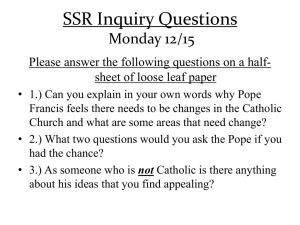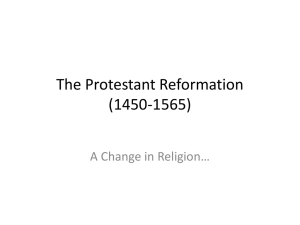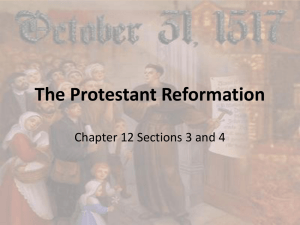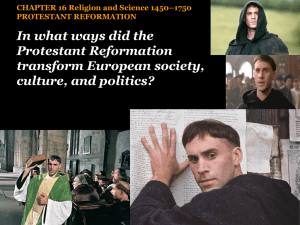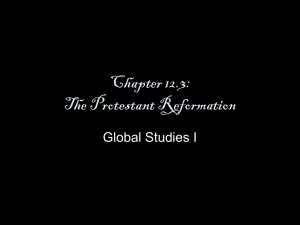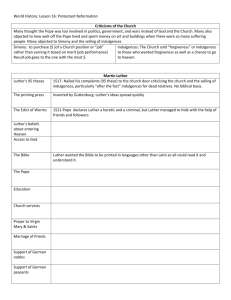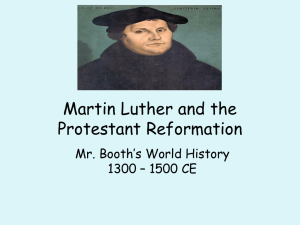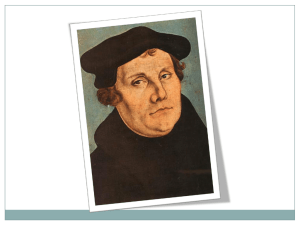Worksheet
advertisement
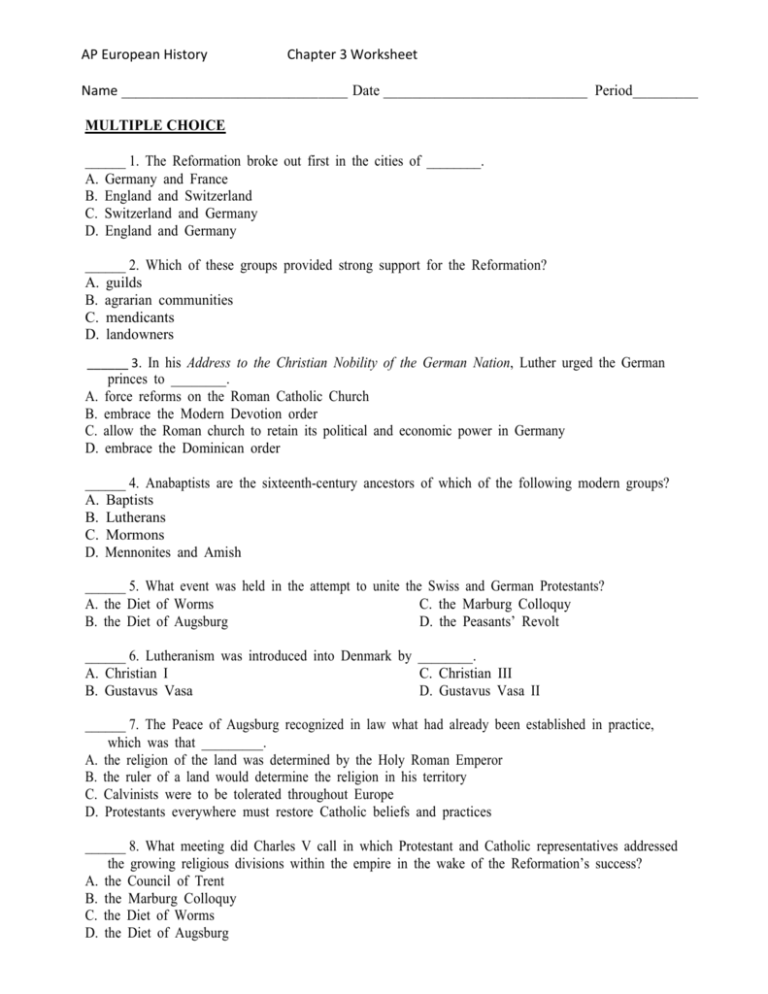
AP European History Chapter 3 Worksheet Name _______________________________ Date ____________________________ Period_________ MULTIPLE CHOICE ______ 1. The Reformation broke out first in the cities of ________. A. Germany and France B. England and Switzerland C. Switzerland and Germany D. England and Germany ______ 2. Which of these groups provided strong support for the Reformation? A. guilds B. agrarian communities C. mendicants D. landowners ______ 3. In his Address to the Christian Nobility of the German Nation, Luther urged the German A. B. C. D. princes to ________. force reforms on the Roman Catholic Church embrace the Modern Devotion order allow the Roman church to retain its political and economic power in Germany embrace the Dominican order ______ 4. Anabaptists are the sixteenth-century ancestors of which of the following modern groups? A. Baptists B. Lutherans C. Mormons D. Mennonites and Amish ______ 5. What event was held in the attempt to unite the Swiss and German Protestants? A. the Diet of Worms C. the Marburg Colloquy B. the Diet of Augsburg D. the Peasants’ Revolt ______ 6. Lutheranism was introduced into Denmark by ________. A. Christian I C. Christian III B. Gustavus Vasa D. Gustavus Vasa II ______ 7. The Peace of Augsburg recognized in law what had already been established in practice, which was that _________. A. the religion of the land was determined by the Holy Roman Emperor B. the ruler of a land would determine the religion in his territory C. Calvinists were to be tolerated throughout Europe D. Protestants everywhere must restore Catholic beliefs and practices ______ 8. What meeting did Charles V call in which Protestant and Catholic representatives addressed the growing religious divisions within the empire in the wake of the Reformation’s success? A. the Council of Trent B. the Marburg Colloquy C. the Diet of Worms D. the Diet of Augsburg AP European History Chapter 3 Worksheet ______ 9. The Act of Succession ________. A. made James VI of Scotland Henry VIII’s heir B. made the heir to the throne the first-born child of a king regardless of gender C. made Anne Boleyn’s children the legitimate heirs to the throne D. gave Parliament the right to choose the next monarch of England ______ 10. The Book of Common Prayer, written by Thomas Cranmer, was imposed on all English churches by the ________. A. Act of Succession B. Diet of Augsburg C. Reformation Parliament D. Act of Uniformity ______ 11. Recognized by the pope in 1528, this group sought to return to the original ideals of Saint Francis and became popular among the ordinary people to whom they directed their ministry. A. the Theatines B. the Oratorians C. the Somaschi D. the Capuchins ______ 12. Which of the following was an influential women’s order founded in 1535 for the religious education of girls from all social classes? A. the Capuchins B. the Ursulines C. the Jesuits D. the Theatines ______ 13. The Roman Catholic Church recognized the need for reform and met from 1545–1563 at the _______. A. Peace of Augsburg C. Council of Trent B. Marburg Colloquy D. Diet of Worms ______ 14. The order co-founded by Bishop Gian Pietro Carafa in 1524, which sought to groom devout and reform-minded leaders at the higher levels of the church hierarchy, was ________. A. the Capuchins C. the Barnabites B. the Theatines D. the Ursulines ______ 15. The new Protestant schools and universities of the 1500s were most likely to teach ________. A. the ideas of humanism B. the ideas of Scholasticism C. strict church doctrine D. Roman Catholicism ______ 16. Scholastic dialectic were promoted and taught by the ________. A. supporters of the Counter-Reformation B. leaders of Lutheranism C. leaders of Calvinism D. teachers at Protestant schools and universities AP European History Chapter 3 Worksheet ______ 17. For which of the following novels is Cervantes best known? A. La Galatea C. El Amante Liberal B. La Gitanilla D. Don Quixote ______ 18. What advantage did an indulgence grant the buyer? A. the granting of an ecclesiastical post B. the founding of a religious order C. release from time in purgatory D. the freedom from the church holiday obligations ______ 19. The events that sparked the Reformation arose from an intersection of which developments? A. the French invasion of Italy and the end of the Great Schism B. anticlerical sentiments and Luther’s call for reform C. the Hundred Years’ War and the election of Pope Leo X D. John Huss’ conviction for heresy and the Thirty Years’ War ______ 20. The Freedom of a Christian, written by Martin Luther, summarized the new teaching of salvation ________. A. through pious actions C. through prayer B. by faith alone D. as the unattainable goal ______ 21. Luther’s response to the German Peasants’ Revolt proved that his reforms were ________. A. religious, not social B. aimed at all facets of German culture and society C. limited to Germany D. more radical than most contemporaries thought ______ 22. Frederick the Wise protected Luther because _______. A. he agreed with the notion of religious reform B. he believed fervently in Luther’s doctrines C. Luther was under his jurisdiction D. he hoped to gain territory from the religious disputes ______ 23. What was the difference between the teachings on salvation of the Roman Catholic Church and those of Martin Luther? A. Luther believed that salvation came from faith alone, while the Roman Catholic Church taught that salvation came from divine mercy and good works. B. Roman Catholics taught that salvation came from faith alone, while Luther believed that salvation came from divine mercy and good works. C. Luther and the Roman Catholic Church had the same beliefs on salvation. D. The Roman Catholic Church taught that salvation came from divine mercy and good works, while Martin Luther did not believe in salvation. ______ 24. Anabaptists desired ________. A. an immediate end to the practice of adult baptism B. an immediate end to the practice of baptism C. more radical reform than Luther desired D. the imposition of a strict social hierarchy based on gender AP European History Chapter 3 Worksheet ______ 25. For what is Ulrich Zwingli known? A. He was the leader of the Swiss Reformation. B. He called the Marburg Colloquy. C. He was the hero of the Swiss Civil War D. He spread Luther’s ideas in Switzerland. ______ 26. What was the outcome of the Marburg Colloquy? A. Luther and Zwingli resolved their differences and formed a single theology. B. The Colloquy splintered the Protestant movement theologically and politically. C. The Colloquy led to the Swiss Civil War. D. The Colloquy established a new church movement. ______ 27. Calvin’s work Institutes of the Christian Religion is considered ________. A. a heretical work even by Protestants B. a rejection of the Catholic theology C. a summary of the beliefs of Anabaptism D. the definitive theological statement of Protestant faith ______ 28. What was the goal of the Marburg Colloquy? A. to work out differences between Swiss and German Protestants and form a mutual defense pact B. to debate the differences between Catholics and Protestants C. to educate Landgrave Philip of Hesse on Protestant theology D. to introduce Ulrich Zwingli and Martin Luther to one another ______ 29. How did Poland react to the Reformation? A. Poland rejected the ideas of the Reformation and persecuted Protestants. B. Poland permitted limited freedoms for the two major faiths. C. Polish leaders demanded that Poles remain faithful to the Roman Catholic Church. D. Poland became a model of religious pluralism and toleration. ______ 30. The Reformation Parliament met for seven years and determined that ________. A. English citizens could determine their own religion B. the Catholic Church would remain the church of England C. Henry VIII would replace the pope’s position over the church in England D. the clergy would be awarded more rights and power ______ 31. King Henry VIII received the title “Defender of the Faith” from Pope Leo X for ________. A. divorcing Catherine of Aragon B. marrying Catherine of Aragon C. defending the seven sacraments against Luther D. promoting Thomas Cranmer to Archbishop of Canterbury ______ 32. Ignatius of Loyola taught good Catholics to ________. A. submit without question to higher church authority and spiritual direction B. bring any reform ideas to a council where they would be considered C. only question the doctrines of the church in privacy to avoid public controversy D. encourage religious innovation AP European History Chapter 3 Worksheet ______ 33. The Council of Trent’s most important reforms concerned ________. A. religious tolerance B. discipline within the church C. transubstantiation D. the power structure of the church ______ 34. Which of the following statements characterizes Protestant views of the popular misogynistic literature of the Middle Ages? A. They completely agreed with this literature. B. They agreed in part with the antimarriage literature, but that was the extent. C. They agreed in part with the antiwoman sentiment, but felt marriage was a necessity. D. They completely disagreed with this literature ______ 35. Marriages in the early modern period were arranged in the sense that they were________. A. dictated by the bride’s parents B. dictated by the groom’s parents C. planned D. determined when the bride reached the age of fifteen ______ 36. Which of these best summarize changing notions about women resulting from the Protestant Reformation? A. Women gained greater legal rights and much greater autonomy. B. Education was thought unimportant, given the emphasis on women as mothers. C. Women were increasingly associated with Eve more than the Virgin Mary. D. Women’s roles were more esteemed, though not greatly expanded. ______ 37. The rationale for Luther’s theology was illustrated by his attack on five of the traditional sacraments; he rejected them because they were _________. A. Catholic B. not supported by the Bible C. more about ritual than piety D. medieval ______ 38. The Swiss Civil Wars illustrated which of these widespread impacts of the Reformation? A. the dominance of Protestantism in Germanic lands B. the violence of the Catholic Church in trying to suppress reform C. violent conflict based on religious differences D. the role of the printing press in an age of religious strife Short Answer: Topic: The Social Significance of the Reformation in Western Europe 7 points 1. In what ways did the Reformation take “steps toward the emancipation of women”? What were the reformers’ views of marriage and on the education of women? Do you think the Reformation improved the lives of sixteenth-century women? Explain. AP European History Chapter 3 Worksheet

